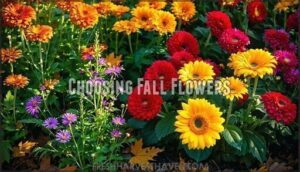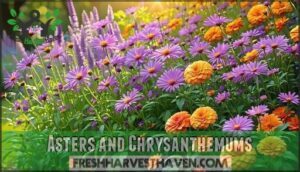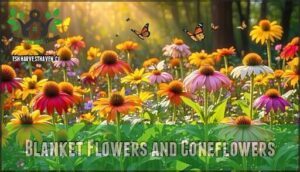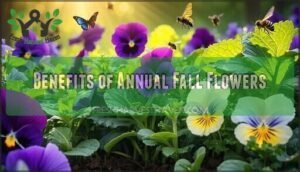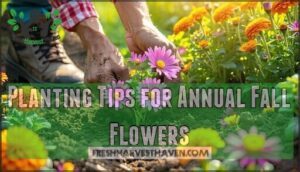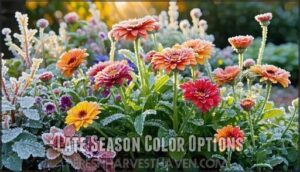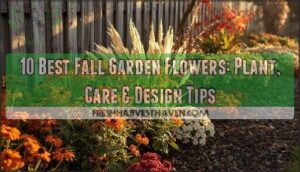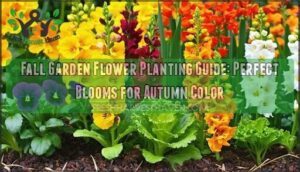This site is supported by our readers. We may earn a commission, at no cost to you, if you purchase through links.
 You’ll find that asters, chrysanthemums, and sedum deliver stunning autumn color when summer blooms fade. These hardy perennials thrive in cooler weather, often blooming until the first hard frost. Asters offer purple, pink, and white daisy-like flowers that butterflies adore, while mums provide classic fall hues of orange, yellow, and burgundy. Sedum’s succulent blooms create striking pink or red clusters. Ornamental grasses like fountain grass add texture and movement, while late-blooming coneflowers extend their season with rich purples and yellows. Plant these champions in well-draining soil with adequate sunlight for maximum impact. Understanding proper timing and companion planting techniques can transform your garden into an autumn masterpiece that keeps giving.
You’ll find that asters, chrysanthemums, and sedum deliver stunning autumn color when summer blooms fade. These hardy perennials thrive in cooler weather, often blooming until the first hard frost. Asters offer purple, pink, and white daisy-like flowers that butterflies adore, while mums provide classic fall hues of orange, yellow, and burgundy. Sedum’s succulent blooms create striking pink or red clusters. Ornamental grasses like fountain grass add texture and movement, while late-blooming coneflowers extend their season with rich purples and yellows. Plant these champions in well-draining soil with adequate sunlight for maximum impact. Understanding proper timing and companion planting techniques can transform your garden into an autumn masterpiece that keeps giving.
Table Of Contents
- Key Takeaways
- Fall Flower Basics
- Choosing Fall Flowers
- Fall Blooming Perennials
- Annual Fall Flowers
- Late Season Color Options
- Frequently Asked Questions (FAQs)
- What are the best fall flowers for color?
- What colors start to come out in the autumn flowers?
- What is the flower for late autumn?
- What are the best flowers for fall color?
- What fall flower does well in the shade?
- What is the flower of late autumn?
- Which fall flower lasts the longest?
- What flowers bloom at the end of August?
- How do you extend fall flower blooms?
- What care do fall flowers need indoors?
- Conclusion
Key Takeaways
- You’ll get the most vibrant late-season displays by choosing hardy perennials like asters, chrysanthemums, and sedum that naturally thrive in cooler temperatures and bloom until first frost.
- Plant your fall flowers in well-draining soil with adequate sunlight, and you’ll extend blooming periods by deadheading spent flowers weekly and providing consistent moisture.
- You can attract essential pollinators during migration season by selecting native varieties like New England asters and goldenrod that provide crucial nectar sources when other flowers fade.
- You’ll create stunning autumn combinations by mixing different bloom types – pair daisy-like asters with ornamental grasses for texture, or combine tubular cardinal flowers with hardy begonias for continuous color.
Fall Flower Basics
You can transform your garden into a vibrant autumn showcase by selecting fall-flowering perennials and annuals that thrive in cooler temperatures.
These hardy plants extend your growing season well into October and November, providing essential nectar for migrating butterflies and late-season pollinators.
Types of Fall-Flowering Perennials
You’ll discover several types of fall-flowering perennials that extend your garden’s beauty into autumn.
Asters varieties bloom in purple, pink, and blue from August through October, while Rudbeckia care involves minimal maintenance for golden blooms lasting until frost.
Late season perennials like Japanese anemones thrive in shade, and Helenium staking supports tall varieties reaching four feet.
Benefits of Late Season Color
Late-blooming flowers transform your garden into a pollinator haven, extending beauty well beyond summer’s peak.
These autumn flower varieties provide essential nectar sources when other blooms fade, supporting struggling bee populations while delivering stunning visual appeal.
Fall garden color boosts mental wellbeing during shorter days, and best fall blooms offer remarkable economic impact by reducing landscape replacement costs, keeping gardens vibrant through frost with late season perennials.
Choosing Fall Flowers
Choosing the right fall flowers depends on your specific growing conditions and aesthetic preferences.
Consider your climate zone, soil drainage, and available sunlight when selecting varieties that’ll thrive through autumn’s changing weather.
Climate and Soil Type Considerations
Your climate and soil quality shape which fall flowers will thrive in your garden.
Plant hardiness zones guide regional suitability, while soil drainage and pH levels determine root health. Well-draining, neutral soils support most varieties, though clay requires amendments and sandy soils suit drought-tolerant species.
Many gardeners find success by researching fall flower zones before planting.
- Check your hardiness zone – Asters excel in zones 3-8, while marigolds prefer warmer southern regions
- Test soil drainage – Heavy clay inhibits asters and coneflowers, requiring compost or sand amendments
- Measure pH levels – Most fall bloomers prefer 6.0-7.0 pH for ideal nutrient uptake and vibrant color
- Consider microclimates – Urban areas with salt stress may limit sensitive species like chrysanthemums
Sunlight Availability and Personal Preference
Your fall garden’s success depends on matching plants to your available sunlight and aesthetic preferences.
Full-sun lovers like black-eyed Susans thrive in sunny spots, while Japanese anemones excel in shade.
Consider bloom time, plant height, and color choices that complement your garden style when selecting late blooming flowers for the best fall garden color.
Plan your garden by considering cool-weather flowers for the best results.
Native Fall Bloomers and Ornamental Grasses
Native plants create thriving local ecosystems while supporting wildlife through natural seed dispersal.
You’ll find New England asters and goldenrod attracting over 40 butterfly species during migration.
Ornamental grasses like little bluestem and switchgrass provide grassland habitats that boost conservation efforts.
These fall-blooming perennials need minimal water, making them perfect for sustainable fall flowers.
Fall Blooming Perennials
You’ll find that fall-blooming perennials offer reliable color when most other plants start to fade.
These hardy plants return year after year, providing consistent late-season interest with minimal effort on your part.
Asters and Chrysanthemums
You’ll find asters and chrysanthemums are the backbone of fall blooming perennials, offering reliable late season color when most gardens fade.
Aster varieties like New England aster reach impressive heights while chrysanthemum care involves pinching back stems for bushier growth.
Their extended bloom time supports migrating pollinators, and both serve as excellent companion plants alongside ornamental grasses, requiring minimal pest control efforts.
Many gardeners buy aster plants to enhance their fall gardens.
Blanket Flowers and Coneflowers
These powerhouse perennials deliver incredible staying power when other flowers fade.
Blanket Flower Care involves minimal fuss—they’ll bloom from June through October in poor soils. Coneflower Varieties like purple Echinacea attract monarchs while providing seeds for goldfinches.
Consider these winning combinations:
- Drought-defying duo – Both species thrive without irrigation
- Pollinator magnets – Bees and butterflies visit constantly
- Winter interest – Coneflower seed heads feed birds
These lateblooming flowers make excellent Companion Plants, creating stunning autumn blooms through first frost.
Fall planting allows for stronger root systems.
Cardinal Flowers and Hardy Begonias
Vibrant cardinal flowers bring stunning red spikes to your fall garden design, thriving in moist conditions where other lateblooming flowers struggle.
Their unique cultivars attract hummingbirds through October.
Hardy begonias complement these perennial plants perfectly, offering continuous blooms until frost.
When winterizing begonias, lift tubers after foliage dies back.
Both species pair beautifully as companion plants in shaded borders, with vibrant cardinal flowers and hardy begonias creating a stunning display.
Annual Fall Flowers
Annual fall flowers give you quick color when perennials start fading, and they’re perfect for filling gaps in your garden beds or revitalizing tired containers.
You’ll love how fast they establish and bloom compared to spring plantings, since cooler temperatures reduce transplant shock while still providing enough warmth for rapid growth, and this makes them a great choice for quick results.
Benefits of Annual Fall Flowers
Annual flowers deliver autumn’s final performance with extending bloom periods that outlast many perennials.
You’ll find quick maturation means pansies and ornamental kale establish rapidly, providing essential nutrient provision for late-season pollinators.
These fall blooms offer reliable pollinator support when other sources dwindle, while maintaining garden brightness through frost.
To enhance your fall garden, you can Find annual options and explore various annual flowers that focus energy on flowering rather than root development, ensuring continuous fall flowers until winter arrives.
Planting Tips for Annual Fall Flowers
Proper soil preparation sets your fall gardening success in motion. Most annual flowers thrive in well-draining soil enriched with compost. August planting gives these frost-tolerant beauties time to establish before winter arrives, ensuring spectacular fall blooms that’ll make your neighbors peek over the fence.
For vibrant hues, consider the best fall flower.
- Soil preparation: Mix compost into existing soil for better drainage and nutrients
- Watering techniques: Water deeply but less frequently to encourage strong root systems
- Fertilizing schedules: Apply balanced fertilizer every 4-6 weeks during growing season
- Sunlight needs: Choose locations with 6+ hours of direct sunlight for ideal blooming
Late Season Color Options
As temperatures drop, you’ll want flowers that can handle cooler weather while still delivering vibrant blooms well into autumn.
The best late-season performers combine extended flowering periods with natural hardiness, giving you months of color that attracts pollinators right up until the first hard frost.
Extended Bloom Periods in Fall Flowers
Fall flowering plants reward you with longlasting fall blooms when you master key care techniques.
Deadheading techniques keep blooms coming by removing spent flowers weekly. Fertilization schedules using balanced fertilizer every 4-6 weeks support continuous flowering.
Watering strategies involve deep, infrequent watering to encourage strong roots. Pruning practices and proper sunlight management maximize your late season garden blooms and fall garden combinations, which are essential for continuous flowering.
Attracting Pollinators With Fall Flowers
Beyond providing stunning autumn displays, fall flowering plants serve as essential nectar sources for pollinators preparing for winter.
Strategic habitat creation through flower selection substantially impacts bee survival and pollinator benefits during this pivotal season.
Smart flower choices create pollinator lifelines when other nectar sources disappear.
Key strategies for attracting pollinators fall include:
- Plant tubular flower shapes like cardinal flowers to attract late-season hummingbirds
- Choose native species such as goldenrod and asters that support 80+ bee species
- Create clustered plantings to boost pollinator visibility and increase visits by 50%
Hardiness and Resilience in Fall Flowers
While many gardeners worry about delicate flowers surviving autumn’s unpredictable weather, hardy fall flowers prove remarkably resilient against nature’s challenges.
These tough performers withstand frost, drought, and wind while maintaining their vibrant displays through season’s end.
Gardeners should also consider adding compost to soil to improve drainage and nutrient density.
| Hardy Fall Flower | Primary Resilience | Zone Range |
|---|---|---|
| Black-eyed Susan | Drought resistance, wind resistance | 3-10 |
| Asters | Frost tolerance, pest resistance | 3-8 |
| Sedum ‘Autumn Joy’ | Soil adaptability, drought resistance | 3-9 |
Plant hardiness and perennial resilience make these selections ideal for unpredictable fall conditions.
Frequently Asked Questions (FAQs)
What are the best fall flowers for color?
Brilliant blooms bring breathtaking beauty when temperatures turn crisp.
You’ll love chrysanthemums, asters, and pansies for reliable color.
Black-eyed Susans and helenium add golden warmth, while Japanese anemones provide elegant whites and pinks through frost.
What colors start to come out in the autumn flowers?
You’ll see rich burgundy and deep purples from asters, golden yellows and warm oranges from black-eyed Susans and helenium, plus vibrant reds from cannas bringing warmth to cooler days.
What is the flower for late autumn?
Chrysanthemums reign supreme for late autumn color, blooming until frost hits. You’ll also find asters, persicaria, and ornamental kale thriving when other flowers fade away completely.
What are the best flowers for fall color?
Like painters creating their final masterpiece, fall’s blooms deliver stunning color when summer fades.
You’ll love chrysanthemums, asters, and black-eyed Susans for vibrant yellows, purples, and oranges lasting until frost hits your garden.
What fall flower does well in the shade?
Japanese Anemones thrive in shady borders, producing elegant pink or white flowers that reach up to five feet tall through fall.
You’ll find they prefer rich, moist soil and flourish in zones 5-
What is the flower of late autumn?
Asters are autumn’s champions, blooming through October and November with daisy-like flowers in purple, pink, and blue.
These hardy perennials provide essential nectar for migrating monarchs and other pollinators when most flowers have faded, making them autumn’s valuable resource.
Which fall flower lasts the longest?
While most fall blooms fade with the first frost, one champion defies winter’s grip longer than you’d expect.
Black-eyed Susans earn their reputation as the longest-flowering perennials, continuing their golden display well into late fall.
What flowers bloom at the end of August?
Black-eyed Susans, asters, helenium, and persicaria burst into bloom during late August, creating stunning displays that’ll last until frost.
You’ll also find marigolds and ornamental grasses adding texture and vibrant colors to your garden borders.
How do you extend fall flower blooms?
Like a gardener coaxing extra days from summer, you’ll stretch blooms by deadheading spent flowers, providing consistent water, and protecting plants from early frost with row covers or mulch.
What care do fall flowers need indoors?
Indoor fall flowers need bright, indirect light and consistent moisture without waterlogging. You’ll want to keep temperatures between 60-70°F and provide good air circulation to prevent fungal issues.
Conclusion
Like a garden’s grand finale before winter’s curtain call, selecting the best fall flowers for late season color transforms your landscape into a vibrant celebration.
You’ll create lasting beauty by choosing hardy perennials that thrive in cooler temperatures and shorter daylight hours.
These resilient bloomers provide essential nectar for migrating butterflies and late-season pollinators.
With proper planning and the right plant selections, you’ll enjoy spectacular autumn displays that extend your garden’s appeal well beyond summer’s end, creating a true vibrant celebration of lasting beauty.
- https://pallensmith.com/
- https://www.awin1.com/awclick.php?awinmid=7833&awinaffid=103504&clickref=gardeningetc-us-1335496891965141427&p=https%3A%2F%2Fwww.crocus.co.uk%2Fplants%2F_%2Fanemone--hybrida-knigin-charlotte%2Fclassid.2476%2F
- https://extension.illinois.edu/blogs/good-growing/2021-10-29-what-makes-plants-bloom-different-times-year
- https://directnativeplants.com/product/cardinal-flower/?srsltid=AfmBOop297ZHzBS9ky4mVtn7pilwWsgh7IQCQrn-qqpgwZuNaxt371WH
- https://hort.extension.wisc.edu/articles/cardinal-flower-lobelia-cardinalis/

